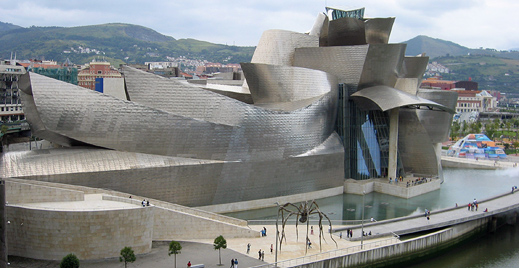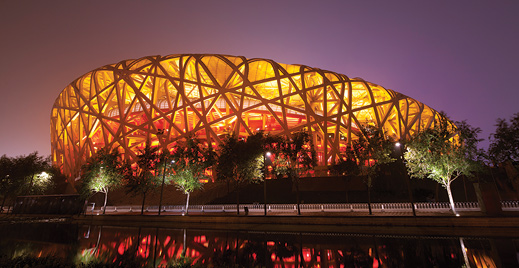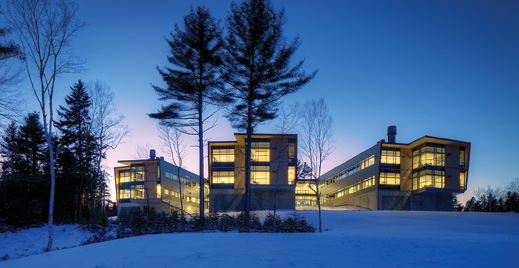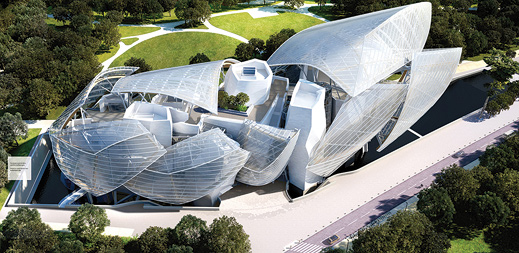Since the unveiling of Frank Gehry?s titanium-skinned?Guggenheim Museum Bilbao?in 1997, we?ve grown accustomed to?eye-popping architectural statements, whether in the complex geometry of Herzog & de Meuron?s?Beijing National Stadium?(also known as the ?Bird?s Nest?) or in the precarious cantilevering of Zaha Hadid?s MAXXI?National Museum?in Rome. If it seems there?s some immensely complicated system being used to engineer these gravity-?defying arcs, ramps, and curves, that?s because there is. But that technology, known as parametric modeling, can do much more than facilitate the fantastic creations of Gehry, Hadid, and their ilk. Increasingly, parametric design is being used not just to make buildings more visually compelling but to precisely tune nearly every aspect of their performance, from acoustics to energy efficiency. It?s not as sexy an application, but it will become far more valuable to architecture and the way we live and work.

The Guggenheim Museum in Bilbao, Spain.
Parametric design software automatically figures out how changing any parameter of a structure will affect other physical aspects. It?s more complex than the computer-?aided design (CAD) software that has been the industry standard since the 1980s. That software essentially works like a digital pencil; it requires a person to move a mouse around to manipulate the lines on an architectural drawing. Today?s parametric technology is more than just a drafting tool. Not only can it model a building and many of its attributes in 3-D, but it can revise a model instantly. If an architect wants to alter the pitch of a roof, for example, the walls then follow the revised roofline automatically. As Hao Ko, a design director at the architectural firm?Gensler, explains, ?The designer is setting the rules and parameters, with the computer doing the iterations. This gives designers more flexibility to explore designs, and we can make changes faster.? It also means that architects are more willing to make changes that can ultimately make a project better.
As the technology has improved, parametric models have been able to accept more and more inputs. Architects can use the software to investigate what a building could be made of or how its natural lighting could be maximized. Or they can virtualize window dimensions and ceiling heights and the way a structure is heated and cooled. ?In any project, there are a million possibilities,? says architect ?Matthew Pierce of?Perkins + Will
Phil Bernstein, an architect and vice president at the software maker?Autodesk, believes parametric technology will help make new buildings more environmentally sustainable. (This is crucial, given that buildings account for 40 percent of the world?s energy use and one-third of all carbon dioxide emissions.) The current industry standard for energy efficiency is?LEED?Leadership in Energy and Environmental Design. Architects who use green features like drought-?tolerant plants and efficient heating, ventilation, and air-conditioning systems can apply for LEED certification.

The signature curves in Beijing?s Olympic stadium arose from a complex geometry that demanded computer modeling.
But critics of this approach point out that it?s hard to measure the outcomes. Parametric technology might provide more precise metrics. How much energy will a building actually need? Or how much might it generate? How much water will it use? These things can be determined during the design process and rapidly optimized?you can adjust the model until you get the results you?re looking for.
That was the case with Perkins + Will?s design for the?Bigelow Laboratory for Ocean Sciences, in East Boothbay, Maine. The firm used software called?Ecotect?Analysis (now owned by Autodesk) to model everything from thermal performance to daylighting?the practice of placing?windows?or other openings in such a way that?natural light can reliably illuminate the interior. As the architects tinkered with the design in a computer, it calculated and analyzed such properties as the building?s floor area, its volume, and the required quantities of materials. They could simulate the thermal performance of different wall, roof, and window assemblies?and evaluate the performance against the cost. They could study how different types of glass would perform?not just in general but on the northeast wall at the building?s exact location, under conditions suggested by long-term weather data.

The MAXXI?National Museum of the 21st Century Arts?in Rome, Italy.
The benefits of parametric technology can similarly be seen in Gensler?s soon-to-be-completed?Shanghai Tower, which at 630 meters will be the second-tallest tower in the world and the tallest in China. Its twisting, curved form was an aesthetic choice, to be sure, but by plugging that geometry into a modeling tool known as?Grasshopper, the designers were able to tweak the shape to minimize the force of winds on the fa?ade. As Ko explains, ?If you have a tall tower like that, you?re studying the different degrees of rotation. It would be tedious if you had to do it manually. Using rotation as one of the parameters, you can run through the various iterations to get to the final situation.?
Idiosyncratic subdivisions
For now, the most familiar built expressions of parametric design remain extreme projects like those created by Zaha Hadid Architects, a firm that is known for avoiding corners, right angles, and familiar typologies. We see a similar avoidance of corners in the astounding 19,000 molded glass-reinforced concrete pieces and 3,500 custom curved glass panels that make up Frank Gehry?s design for the?Louis Vuitton Foundation for Creation, a $100-million-plus museum scheduled to open in Paris next year.

Natural lighting was one of the elements that architects tried to maximize in the Bigelow Laboratory for Ocean Sciences.
Even so, many architects (and their clients) are increasingly asserting that gesture and complexity for their own sake are not enough. Accordingly, the building industry is becoming more knowledgeable about improving a structure?s function. Architecture graduates arrive at firms armed with expertise in parametric tools such as Revit, Grasshopper, and Rhino; they may never have designed without the help of computers, and parametric modeling is familiar to them. Among builders, engineers, and architects, the adoption of advanced digital tools for what?s known as?building information modelingsurged from 28 percent in 2007 to 49 percent in 2009 and 71 percent in 2012.

Some of the most dramatic forms designed with parametric technology have come from Frank Gehry, whose Louis Vuitton Foundation for Creation is soon to open in Paris.
And while such technology is useful for formally complex buildings, even simpler forms should benefit from it. Architects Nataly Gattegno and Jason Kelly Johnson of?Future Cities Lab?believe parametric design can change how we think about floor plans of houses or grid patterns of planned communities. ?Do these houses all have to be the same?? Gattegno asks. Parametric modeling ?could open up all kinds of possibilities of what a house could be.? Mass-produced housing might become less cookie-cutter, more idiosyncratic, and more economical and energy efficient.?
Similarly, the technology could reshape urban planning. Just as it can create a detailed representation of a wall, it can model an entire neighborhood to determine the optimal size and shape of the various structures in it, says Autodesk?s Bernstein.?Awkwardly scaled McMansions might be rethought?to make more efficient use of lots, building materials, and energy.?
Parametric modeling can even take human proportions and movement into account. A company called ?AnyBody Technology, for example, does full-body physical simulations for the design of cockpits or workspaces. The company has begun collaborating on R&D with architects so that a parametric model can be used to simulate a body walking through a given space. Eventually, architects could design, say, a nursing home in a way that optimized walking distances or ergonomics.
Of course, models are still mere simulations. And one thing that this modeling can?t automatically account for?yet, anyway?is human behavior. Bernstein told me that when Autodesk built its LEED-certified headquarters, its designers ?energy-modeled the hell out of it? in parametric software only to find out that the building used 30 percent more energy than they had anticipated. Why? Among other things, after the lights automatically went off at 6:30 p.m., cleaning crews turned them back on and didn?t shut them off again.
Allison Arieff is a content strategist for SPUR, an urban planning and policy think tank in San Francisco, and a contributing columnist at the New York Times.
Source: http://www.technologyreview.com/review/517596/new-forms-that-function-better/
Shane Larkin Shannon Guess Richardson Darren Daulton Andrew Wiggins James Gandolfini funeral Nelson Mandela Dead Dylan Redwine



















